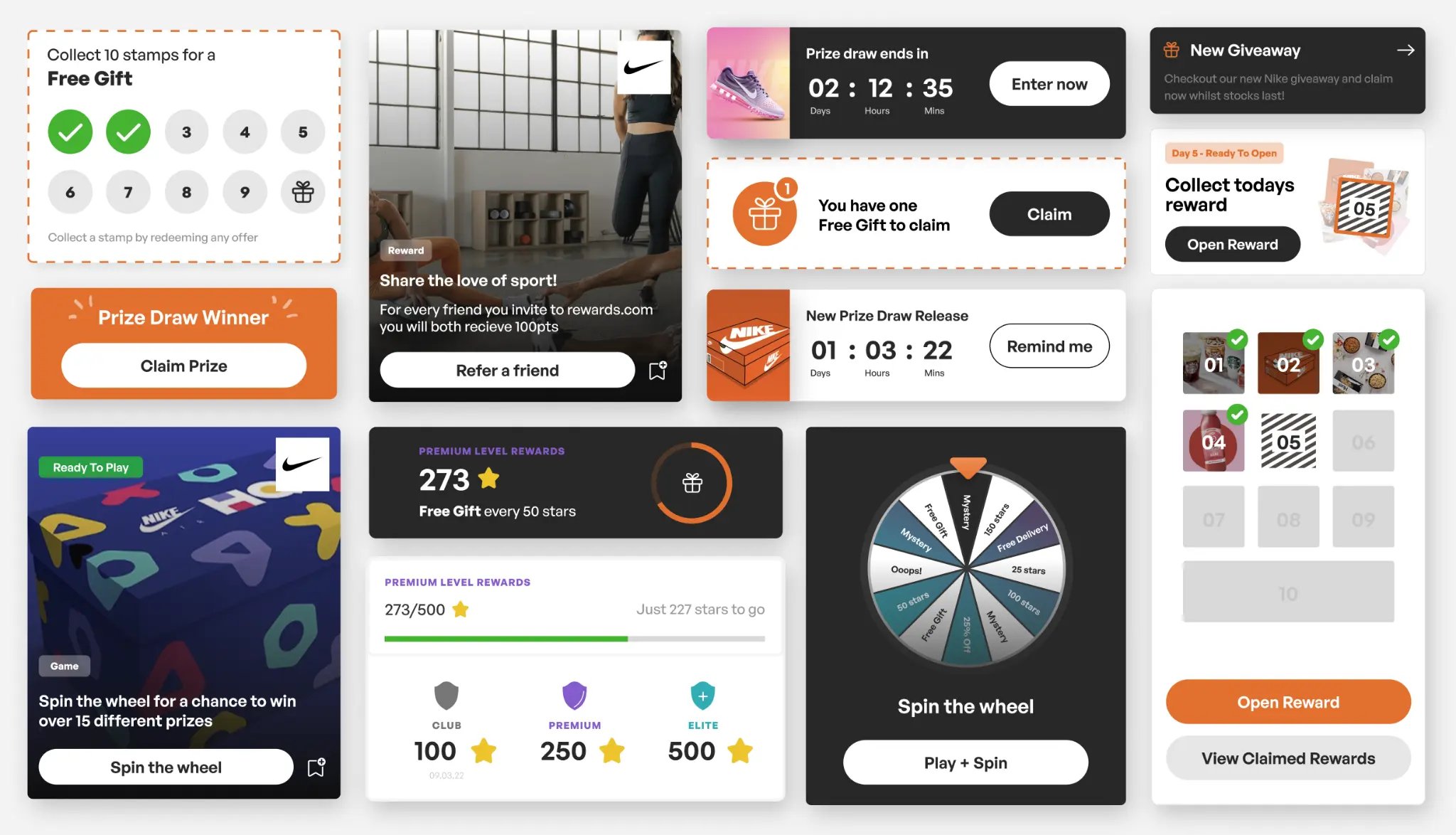The modern customer wants more than just great products. They have an appetite for ongoing digital engagement. The meaningful deepening of digital connections has significantly impacted brand loyalty in 2025.
In this article, I’ll cover what digital customer engagement means for brands like yours and why you need to take advantage of it.
 |
Written by: |
Contents:
Key Takeaways
|
Effective digital engagement helps create emotional connections that transform customers into loyal advocates. |
|
|
|
Every digital touchpoint that uses personalisation based on behaviour patterns and preferences makes customers feel valued and understood. |
|
|
Digital engagement initiatives that employ loyalty programmes enhance customer retention and average spend. |
|
|
Measuring engagement through the right metrics lets you enhance strategies and prove clear ROI to stakeholders. |
What is Digital Customer Engagement?
It encompasses all the ways your brand interacts with customers online, utilising digital channels and technologies. This covers every experience the customer has along the way — from the first click on your website to an email follow-up after purchase.
Digital engagement, essentially, is about creating relationships that make people feel valued via memorable interactions.
Effective online engagement is a matter of being strategically present in the channels that matter to your customers and where they expect to hear from you.
What is the difference between digital customer engagement and traditional engagement?
Traditional customer engagement relies on face-to-face interaction and physical touchpoints. Think physical store visits, printed mailers and phone calls. These techniques operate on the scale of days or weeks.
Meanwhile, digital engagement happens in real-time or near-real-time, which allows for instant intervention.
The most significant difference is in the availability of data. Where traditional approaches offered limited data on a customer’s behaviour, digital engagement gives you unprecedented, actionable information on how your customers actually interact with your brand.
What are the Key Components of Effective Digital Engagement?
ConsistencyThe foundation of digital engagement. Your brand voice, values and service should feel consistent across each channel. |
|
Relevance Makes every interaction meaningful to the customer. This would include knowing their preferences, purchase history, and their stage in the customer journey. |
ResponsivenessMakes customers feel that you respect their time. This could be either via an automated chatbot’s instant reply or email follow-up right on time. |
Value exchangeMakes interactions worthwhile and memorable for all parties. In exchange for their attention and their data, customers expect something of value — information, entertainment, solutions, or special offers. |
Emotional connectionEmotional connection is what converts transactional relationships into loyal ones. Digital tools make it easier for people to engage, but finding ways to add authentic human elements like empathy and understanding is crucial. |
Why is Digital Customer Engagement Important?
So what exactly happens when you connect with customers? Let’s explore the benefits of effective digital engagement.
Effect on business expansion and revenueEngaged customers spend more. People who feel attached to your brand are more likely to raise their average order value and frequency of purchase.
When it comes to profitability and share of wallet, engaged customers outperform the average by 23%
|
Customer retention and loyalty benefitsConsistent, meaningful digital exchanges build emotional connections, making engaged customers hesitate before moving to competitors. These loyal customers get less and less price-sensitive the longer you serve them. If they feel as though your brand understands who they are and values how they think, they’re willing to pay a little bit more for that relationship than to go hunt down an extra 10 or 20% discount elsewhere. Positive brand experiences can result in 140% more spending by customers. Engagement also helps you spot potential churn before it occurs. By watching engagement metrics, you’ll be able to identify red flags early and intervene to re-engage customers who could be dropping off. |
The new competitive advantage in the digital ageAnd in the expanding market of similar products and services, it is your customer experience that helps you stand out. Digital engagement that goes above and beyond can make a difference when other competitive advantages have disappeared. These digitally savvy companies are also better at responding to market changes. This ongoing feedback loop allows you to get an early look at the evolving preferences and needs of your customers, as well as changes in the market. |
What are the Key Digital Customer Engagement Channels?
Effective online engagement is a matter of being strategically present in the channels that matter to your customers and where they expect to hear from you. Here’s how you can do that:
-
Social media platforms: Broadcast to audiences, have one-on-one conversations, then use social listening to drive brand conversations
-
Live chat: Optimise conversions with live chat that provides immediate support.
-
Email: The versatile workhorse that offers readers substantial time and space to absorb detailed information while still feeling personally relevant to their needs
-
Mobile platforms: Where most brand interactions occur today. Push notifications and offline functionality make it easier to stay connected even when customers aren’t actively browsing.
-
Interactive content: Interactive aspects of your website, such as quizzes, ROI calculators, and polls, can help turn passive browsers into active participants
But don’t silo these channels like they’re separate. They should be a connected series of touchpoints in your customer’s relationship with your brand.
What are Digital Customer Engagement Best Practices?
So how do you unlock those advantages for your brand?
Robust omnichannel engagementAn omnichannel strategy empowers your customers to enjoy seamless experiences across all digital and physical touchpoints. This way, they can start a conversation on Twitter, pick it up in email, and finish it on your website without repeating themselves. Brands that excel at creating an omnichannel customer experience keep 89% of their customers. The secret is centralised data that evolves with the customer, not disconnected information that becomes repetitive. Your systems need to know who customers are, no matter where or how they connect with you. |
Personalisation tacticsPersonalisation done well leads to customer engagement. The result is a direct increase in revenue. |
Self-service optionsToday’s customers prefer to solve simple issues alone, even if it means avoiding support. Self-service tools allow this while also saving your team time. |
Proactive engagementWhen you’re reactive, you serve the customer only when they ask for something — a question, a complaint, or a service request. While necessary, this method leaves you constantly playing catch-up. |
Hyper relevant loyalty and reward programmesRunning a loyalty programme means customers get rewarded for their ongoing loyalty to a brand. Digital rewards enable you to tailor your offers to different needs and buying habits. 74% of shoppers would interact more with brands if they had the option to progress through tiers based on yearly spend. |
Virtual events and webinarsVirtual events are shared experiences that build a community around your brand. These online sessions create a level of direct interaction that one-way content just can’t achieve. |
Introduce gamificationGamification uses game design elements in non-game contexts to generate fun and increase user engagement. In a gamified loyalty programme, you generally have progress bars, achievement badges, or a spin-to-win wheel for a more immersive experience. Providing gamified experiences can boost customer engagement by 47%. The psychology behind gamification leverages deep-seated human cravings for mastery, achievement, and recognition. Entering prize draws or climbing leaderboards lets customers feel a sense of accomplishment associated with your brand.
|
Building an online communityOnline communities turn one-to-many broadcasting into many-to-many conversations. These spaces (forums, social groups, standalone platforms) are where your customers interact with one another and with your brand. |
Leveraging AI and technologyThe days of smart tech being limited to tech giants are over. Today's AI-based tools make sophisticated digital engagement available to all businesses. This improved efficiency reduces first response time by 37% and resolution time by 52%.
|
How to Measure Success in Digital Customer Engagement
Online engagement delivers business results when accurately measured. The right metrics show what works and where improvements can have the greatest impact.
Track key metrics and KPIs
Monitor how customers interact with your digital footprint using:
- Time spent on your sites and mobile apps
- Pages viewed per visit
- Social media engagement rates
- Email opens and click-through rates
- Video completion rates
Conversion metrics also show you how engagement influences certain outcomes.. Track how active your engaged customers are at:
- Completing purchases
- Subscribing to newsletters or demos
- Downloading resources
- Sharing content with others
Customer lifetime value reveals the long-term impact of engagement. More engagement generally results in customers who make more frequent purchases and spend more per purchase.
Analytics frameworks
Attribution models enable you to identify which touchpoints are driving decisions. Look at every interaction in the customer journey, and not just the last click before a purchase.
Cohort analysis also indicates how engagement habits change for various customer segments over time. This gives you an idea of whether your strategies work better or worse for newer customers.
Last but not least, journey mapping bridges analytics with lived experiences by focusing on:
- Strong engagement points to reinforce
- High churn areas requiring attention to increase sales
- Unexpected routes customers take
Customer satisfaction measurement
Net Promoter Score (NPS) indicates the probability of your customers recommending your brand to their friends. Just one question—“How likely is it that you would recommend us?” —offers powerful insight into the emotional connections present in digital interactions with customers.
Beyond that, Customer Satisfaction Score (CSAT) takes things one step further by measuring immediate reactions following specific touchpoints. Track these metrics across your digital channels to determine which user experiences bring joy to your customers and which need to be polished.
Meanwhile, the Customer Effort Score (CES) focuses on how easy the service was rather than how satisfied the customer felt. This metric recognises one basic truth of digital interaction: customers want zero-friction experiences. And the fewer issues customers face, the more likely they are to come back.
What are the Common Digital Engagement Challenges and Their Solutions?
Well-planned digital engagement strategies have obstacles, too. Here are some ways to help overcome the most common obstacles that derail your efforts:
-
Channel overload: Prioritise platforms where your target audience spends their time. Quality interaction on three channels is better than mediocre presence on ten.
-
Disconnected user experience: You need to have a single brand voice style guide, and your team members need complete clarity of how this should be delivered across channels. Keep alignment alive through regular cross-team meetings.
-
Data silos: Create a cohesive customer data platform that consolidates information from all touchpoints. Tearing down these walls is typically what leads to discoveries that are otherwise obscured.
-
Privacy: Be transparent about data use and put our customers in control of their information. Transparent opt-in policies and preference centres build trust and maintain your compliance with the rules.
-
Measurement challenges: Begin with a small set of meaningful metrics aligned directly to business goals, as opposed to monitoring every data point you can find. Focus on trends over time, not individual numbers.
-
Resource constraints: Optimise routine engagement tasks to keep your team focused on high-value interactions. A lot of modern budget tools are also providing a level of automation that was really only available to enterprise brands.
-
Digital fatigue: Be deliberate with each point of contact and provide value. Respect your customers’ time and privacy by contacting them only when you have something really worth saying.
-
Staying ahead of new technology: Rather than chasing every new platform or tool, assess innovations in terms of their ability to address the specific pain points your customers experience.
Building Digital Relationships That Last
Digital engagement is no longer transactional but rather an ongoing conversation for brands. The companies that win tomorrow will blend technology with authentic human connection.
And your digital engagement strategy is that much stronger when it:
- Adjusts to evolving customer needs
- Generates emotional ties beyond the rational gains
- Emphasises quality of interactions over quantity
- Evolves through robust tracking data and customer input
The tools will continue to change, but the principles won't: listen before you talk, think before you respond, focus on continuously improving and always deliver value.
FAQs
What is digital customer engagement?
It is a sum of all the interactions that your customers have with your brand on your online channels, including your website, social interactions, email, and apps. It covers all meaningful communication channels that influence their purchase decision.
Why does digital customer engagement matter in building brand loyalty?
Compelling digital engagement turns casual browsers into repeat customers who spend more and stay longer. It both lowers customer acquisition costs and fosters customer loyalty while also giving you valuable information for increased customer satisfaction.
Which factors contribute to a successful strategy for digital customer engagement?
A good mix of personalisation, omnichannel communication, self-service opportunities, and the building of community is crucial to your digital strategy. Applying customer data responsibly, delivering the right blend of automated and human interaction, and ensuring consistent messaging make for a great user experience.
How does personalisation enhance digital customer engagement?
Personalisation demonstrates your understanding of your customer’s needs. You can harness this by analysing behaviour patterns and preferences to deliver tailored content, suggestions and offers that speak directly to what is relevant – and even provocative – increasing engagement and sales.
What role does social media play in digital customer engagement?
Social media enables two-way conversations through which customer service teams can build relationships. These are the places to show your personality, solicit feedback, address concerns publicly, and drive customers toward more meaningful connections.
How can businesses measure the success of their digital customer engagement efforts?
Measure engagement via conversion rates, customer lifetime value, and retention metrics. Track the Net Promoter Score to measure loyalty, analyse the digital marketing performance campaign, and calculate the ROI.
What are a few of the key issues you see with digital customer engagement strategies?
Businesses often battle with data silos, inconsistent messaging across channels, and privacy concerns. Even established companies struggle with technical integration issues, limited resources, and evolving customer expectations. Small businesses also face added budget constraints.
How do omnichannel communications affect customer engagement and loyalty?
Omnichannel communication creates seamless, personalized experiences as customers move between platforms. With your customer relationship management (CRM) system there to unite these touchpoints, your clients have the opportunity for seamless experiences without duplication, further building their relationship with your brand.
What are the key technologies for enabling digital customer engagement?
A strong technological foundation includes a powerful customer experience (CX) platform, loyalty programme, and data analytics tools. The provision of advanced cloud-based solutions also allows for efficient customer service and automation of common tasks in order to improve customer satisfaction.
Author Bio, Written By:
Mark Camp | CEO & Founder at PropelloCloud.com | LinkedIn
Mark is the Founder and CEO of Propello Cloud, an innovative SaaS platform for loyalty and customer engagement. With over 20 years of marketing experience, he is passionate about helping brands boost retention and acquisition with scalable loyalty solutions.
Mark is an expert in loyalty and engagement strategy, having worked with major enterprise clients across industries to drive growth through rewards programmes. He leads Propello Cloud's mission to deliver versatile platforms that help organisations attract, engage and retain customers.




.png)